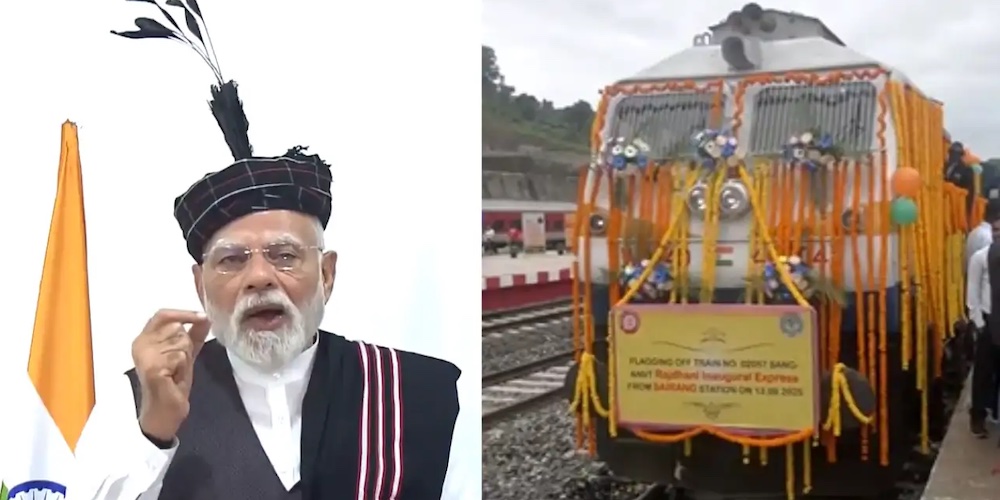Transforming North East

Prime Minister Modi has inaugurated the Bairabi–Sairang railway line in Mizoram, built at a cost of over ₹8,000 crore, connecting Aizawl to the national rail network for the first time
In Manipur, Prime Minister Narendra Modi laid the foundation stone of multiple development projects worth over Rs 7,300 crore at Churachandpur on September 13. The projects include 5 National Highways, Manipur Urban Roads, and drainage and asset management improvement project.
Along with this, Prime Minister inaugurated and laid the foundation stone of major infrastructure and industrial development projects worth over Rs 18,530 crore in Assam.
Beyond individual projects, the Northeast has witnessed a systematic infrastructure expansion through multiple sanctioned initiatives by the Modi government in recent years.
Since FY 2022–23, 17 new railway surveys covering 1,790 km have been approved under the PM Gati Shakti National Master Plan to identify future expansion corridors. Key ongoing projects include the Jiribam–Imphal and Dimapur–Kohima lines, which aim to strengthen strategic and inter-state connectivity. Additionally, several gauge conversion and doubling works are progressing, addressing both passenger and freight needs. These efforts reflect the Centre’s long-term vision to fully integrate the region into the national railway grid.
The Ministry of Railways is spearheading a massive transformation in the North Eastern Region, with record investments aimed at bridging infrastructure gaps and boosting connectivity. Since 2014, the railway budget allocation for the region has increased fivefold, reaching a cumulative ₹62,477 crore, including ₹10,440 crore for the current fiscal year. Railway projects worth ₹77,000 crore are currently underway, marking the highest level of investment the region has ever seen.
A significant highlight of this progress was the inauguration of the Bairabi–Sairang railway line in Mizoram by Prime Minister Narendra Modi. Built at a cost of over ₹8,000 crore, this 51-kilometre line will connect Aizawl to the national railway network for the first time since independence.
With 143 bridges and 45 tunnels constructed across challenging terrain, the construction is an engineering marvel with one of the bridges taller than Qutub Minar. Beyond passenger convenience, the line will also improve freight movement, open new markets for local produce like bamboo and horticulture, and provide a strong boost to tourism and employment.
Prime Minister also flaged off three new train services from Sairang to Delhi (Rajdhani Express), Kolkata (Mizoram express) and Guwahati (Aizwal Intercity).This firmly places Mizoram on the map of India’s development story.
The Prime Minister also laid the foundation stone for multiple road projects, including the Aizawl Bypass, Thenzawl–Sialsuk, and Khankawn–Rongura roads. The 45 km Aizawl Bypass, costing over ₹500 crore under the PM-DevINE scheme, will ease city traffic and improve connectivity.

Besides, the Prime Minister laid the foundation stone for the Chhimtuipui River Bridge on the Lawngtlai–Siaha Road, which will ensure all-weather connectivity, reduce travel time and facilitate cross-border trade under the Kaladan Multimodal Transit framework.
It may be noted that the Ministry of Road Transport and Highways (MoRT&H), responsible for the development and maintenance of National Highways, has constructed 16,207 km of National Highways in the Northeast Region (NER). The government’s continued investments in roads, railways, and rural transport projects are reshaping the region, enhancing mobility, and opening up new opportunities for local communities.
A notable example of this commitment is the approval of a 15 km road construction project between Mangaldoi and Mazikuchi in Assam, costing ₹45.31 crore. Approved in August 2025, the project will be implemented under the North East Special Infrastructure Development Scheme (NESIDS) – Roads.
Under the Pradhan Mantri Gram Sadak Yojana (PMGSY), 17,637 road works covering 89,436 km and 2,398 bridges have been sanctioned in the North Eastern Region. Of these, 16,469 road works spanning 80,933 km and 2,108 bridges have been completed, significantly improving last-mile connectivity in remote and rural areas.
The same progress in the region has been made in the fields of Digital Connectivity and Mobile Services. Multiple government-funded projects, including BharatNet and others supported by Digital Bharat Nidhi, have enhanced digital connectivity in the Northeast by making Gram Panchayats service-ready and commissioning mobile towers across the region.
Likewise, under the Regional Air Connectivity (UDAN) Scheme, the Ministry of Civil Aviation has introduced the Regional Connectivity Scheme – UDAN to improve air travel access from airports that were previously unserved or underserved. This initiative has helped establish numerous routes, linking various airports and heliports across the North Eastern Region.
For decades, Northeast India was viewed as a distant frontier, rich in culture but lacking the infrastructure needed to unlock its full potential. But things are changing.
With the Act East vision of the Central Government, the Northeast has moved from the margins to the mainstream. What was once seen as a remote corner is now recognized as a front runner in India’s growth story. Unprecedented investments in railways, highways, air connectivity, and digital infrastructure have accelerated development across the eight states, from the bamboo covered hills of Mizoram to the peaks of Sikkim and the tea estates of Assam.
The Act East vision is the strategic framework of making the Northeast a vital gateway to India’s engagement with Southeast Asia while also ensuring balanced development within. As articulated in the Prime Minister’s words “For us EAST means Empower, Act, Strengthen and Transform” a guiding philosophy that underpins every policy initiative in the region. From infrastructure and digital connectivity to education, healthcare and livelihoods these efforts are focused on creating opportunities, improving access and enhancing the quality of life across the eight states.
Today, the region stands not just transformed but empowered, with better connectivity, stronger economies, and a renewed sense of purpose. The story of the Northeast is now one of peace, progress, and prosperity, a true reflection of a Viksit Bharat in the making.


